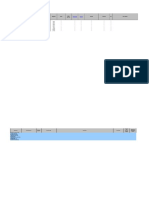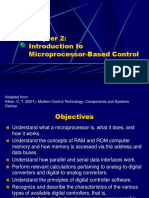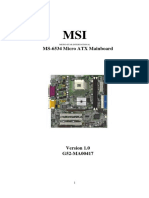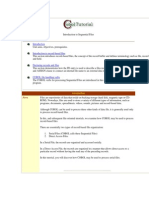Dvrview 32-Bit Windows Upgrade: Power Electronics Group
Uploaded by
wmthibDvrview 32-Bit Windows Upgrade: Power Electronics Group
Uploaded by
wmthibPOWER ELECTRONICS GROUP
DVRView
32-bit Windows Upgrade
Software Design Document
REVISION LOG
Rev.
Date
Description
0.1
1.0
1.1
January 17, 2002
March 7, 2002
May 3, 2002
Draft
Initial Release
Incorporate DVRView_SDD11.doc
POWER ELECTRONICS GROUP
TABLE OF CONTENTS
1.
GENERAL............................................................................................................................................................................... 4
1.1.
SCOPE.................................................................................................................................................................................4
1.2. PRODUCT DESCRIPTION...............................................................................................................................................4
1.2.1.
General Functionality.............................................................................................................................................4
1.2.2.
Interface Requirements ..........................................................................................................................................4
2.
1.3.
REFERENCES.....................................................................................................................................................................5
1.4.
DEFINITIONS....................................................................................................................................................................5
CHANGES FOR 32-BIT OPERATION............................................................................................................................. 5
2.1. COMMUNICATIONS ......................................................................................................................................................5
2.1.1.
OpenComm & CloseComm....................................................................................................................................5
2.1.2.
ReadFile and WriteFile...........................................................................................................................................5
2.1.3.
Communications Thread........................................................................................................................................5
2.1.4.
Thread Events .........................................................................................................................................................6
2.1.5.
Formatted Transmissions......................................................................................................................................6
2.2. MISCELLA NY...................................................................................................................................................................6
2.2.1.
Replacement of 0 parameters with NULL...........................................................................................................6
2.2.2.
Modification of About Diaglog............................................................................................................................6
3.
4.
APPLICATION CORRECTIONS...................................................................................................................................... 7
3.1.
MINUMUM to MINIMUM .............................................................................................................................................7
3.2.
DEMO MODE MONITOR SELECTION LOCK-OUT...............................................................................................7
ADDITTIONS AND MODIFICATIONS ........................................................................................................................... 7
4.1.
OPTIONS MENU SELECTION RE-NAME................................................................................................................7
4.2.
PF/KVAR AND PF REFERENCE EDIT WINDOW CHANGES..................................................................................7
4.3. VOLTAGE ADJUST CHANGES .....................................................................................................................................7
4.3.1.
PARAMETER vs. MONITIOR.............................................................................................................................7
4.3.2.
DATA DISPLAY....................................................................................................................................................8
4.3.3.
DATA STORAGE...................................................................................................................................................8
Prepared for Leroy Somer
Page 2 of 10
May 3, 2002
POWER ELECTRONICS GROUP
4.3.4.
PARAMETER ACCESS.........................................................................................................................................8
4.4. PF/KVAR............................................................................................................................................................................8
4.4.1.
PARAMETER vs. MONITOR ..............................................................................................................................8
4.4.2.
DATA DISPLAY....................................................................................................................................................8
4.4.3.
DATA STORAGE...................................................................................................................................................9
4.4.4.
PARAMETER ACCESS.........................................................................................................................................9
5.
6.
TESTING PLATFORMS ..................................................................................................................................................... 9
5.1.
WINDOWS 95 ...................................................................................................................................................................9
5.2.
WINDOWS 98 ...................................................................................................................................................................9
5.3.
WINDOWS NT..................................................................................................................................................................9
5.4.
WINDOWS 2000 .............................................................................................................................................................10
DEVELOPMENT ENVIRONMENT.................................................................................................................................10
6.1.
PC PLATFORM ...............................................................................................................................................................10
6.2.
DEVELOPMENT TOOLS ...............................................................................................................................................10
6.3.
REGULATOR...................................................................................................................................................................10
Prepared for Leroy Somer
Page 3 of 10
May 3, 2002
POWER ELECTRONICS GROUP
1.
GENERAL
1.1.
SCOPE
This document comprises the design of the 32-bit Windows upgrade of the DVRView application software
used for communications with a Regulator, Parameter display, and editing and data display.
1.2.
PRODUCT DESCRIPTION
1.2.1.
General Functionality
The DVRView software is an application that is a graphical interface to a microprocessor-based
voltage regulator. The application provides a graphical means for an individual to observe and
modify parameters and data. The program interfaces to the regulator using one of two methods,
either a serial connection or a modem based cable connection. Parameters may be both displayed
and edited. Data inputs may be observed and displayed in several ways: Histogram, VU Meter,
Strip Chart or Analog Meter.
The application was originally written to run on a 16-bit Windows platform. The main purpose of
this upgrade is to convert the program to run on 32-bit Windows platforms, namely Windows
95/NT/98/2000.
Other changes to the application were requested to alter existing functionality or correct errors that
were present in the original version.
1.2.2.
Interface Requirements
1.2.2.1. Serial Connection
The serial port connection is selectable by the user. The operator may choose from Comm
Ports 1 through 8. The other settings for the serial communications link are not accessible
to the user and were hard coded in the original application:
BAUD
Data bits
Parity
Stop bits
9600
8
None
1
1.2.2.2. Modem Cable Connection
This connection is similar to the straight serial connection in its set up. The Port to
which the modem is connected is selectable by the operator. Similarly, the
communications parameters for the connection to the modem through the COMM port
remains hard coded in the application software as in the original version.
Prepared for Leroy Somer
Page 4 of 10
May 3, 2002
POWER ELECTRONICS GROUP
BAUD
Data bits
Parity
Stop bits
9600
8
None
1
The operator is allowed to configure the Modem initialization, Hang up and the Dial
Strings through a dialog window.
1.3.
REFERENCES
Specification Systems Operation Testing and Adjusting Digital Voltage Regulator
Caterpillar
SENR5833-02
April 1999
1.4.
2.
DEFINITIONS
CHANGES FOR 32-BIT OPERATION
Several library routines have either changed or are no longer supported when comparing the 16-bit and 32bit development environments. The calls to routines that still exist were modified when necessary to allow
continued operation and compilation. When an older methodology or routine was no longer supported, it
was replaced with a 32-bit equivalent.
2.1.
COMMUNICATIONS
2.1.1.
OpenComm & CloseComm
These routines are not supported in the 32-bit development environment. They were used to open
and close the communications ports. In the 32-bit environment they have been replaced by the
OpenFile and CloseHandle routines.
2.1.2.
ReadFile and WriteFile
The 16-bit routines for reading and writing to a COMM port were ReadComm and WriteComm. The
32-bit replacements for these routines are ReadFile and WriteFile. Reading and writing in Win32 is
significantly different from reading and writing serial communications ports in 16-bit Windows.
Win32 reading and writing can involve many more functions and choices. These new routines to
read and write the Comm port allow the use of the overlapped method of communication, which
provides for the possibility of other communications threads to be run simultaneously and for
these threads to work in the background of the application.
2.1.3.
Communications Thread
Rather than utilizing the methodology of 16-bit Windows, WIN32 requires a separate thread be
created for controlling the communications. This thread is monitored for the transmission and
reception of communications. The thread is set up as overlapped so that the communications does
Prepared for Leroy Somer
Page 5 of 10
May 3, 2002
POWER ELECTRONICS GROUP
not become a bottleneck for the application. For instance, a transmission is started and then the
main application continues to run. The thread for the communications takes care of completing the
transmission. In this way one does not need to wait for the transmission to be completed before
continuing on with rest of the application.
2.1.4.
Thread Events
Due to the new method of communications being used, thread events had to be created for the
handling of communications. An event thread was created for both reading and writing to the
COMM port.
2.1.5.
Formatted Transmissions
It was necessary to format the transmission of CDUdata requests to use at least two digits for the
CDU number. This was due to the fact that when run on the Windows NT operating system, if
only a single digit was used for CDUs 1- 9 the communications failed. These CDUs needed to be
sent as 01-09 in order for the communications to function properly. The single digit sends caused
the communications protocol to hang. The other Windows platforms did not exhibit this problem.
No deleterious effects resulted from the use of the two-digit CDUs on any tested Windows
platform. The modification was implemented in the QueryNextCDU() routine.
2.2.
MISCELLANY
2.2.1.
Replacement of 0 parameters with NULL
Several routines would not compile properly under the new environment with their parameters as
they were for 16-bit development. These routines were SendMessage, PostMessage and
SendDlgItemMessage. In these routines, additional message information may be passed in the
third and fourth parameters. In the original code these value, when not actually being used, were
filled in with 0. In the new development, these routines would cause compiler errors when a 0 was
passed for those parameters. Instead of the 0 a NULL was passed and this allowed proper
compilation.
2.2.2.
Modification of About Diaglog
The About dialog was modified from the Win 3.11 version as the percent resource free attribute is
not supported in the 32-bit world. Instead the size of the physical memory and the amount of
physical memory in use is reported to the user.
The information about the Windows Platform being run has also been updated. The application
will report, through a query to the operating system, which operating is currently being run.
Prepared for Leroy Somer
Page 6 of 10
May 3, 2002
POWER ELECTRONICS GROUP
3.
APPLICATION CORRECTIONS
3.1.
MINUMUM to MINIMUM
The resource for the parameter-editing window contained a spelling mistake. The word minimum was
misspelled as minumum. This was corrected throughout the application.
3.2.
DEMO MODE MONITOR SELECTION LOCK-OUT
The demonstration mode of the original application would prevent an operator from re-entering the Monitor
menu selection once that menu selection had been exited under the 32-bit operating systems. The code was
modified to allow re-entrance into the Monitor portion of the application if it had previously been accessed.
4.
ADDITTIONS AND MODIFICATIONS
4.1.
OPTIONS MENU SELECTION RE-NAME
The VIEW menu selection choice named OPTIONS was renamed PARALLELING PARAMETERS. This
was a simple modification made to the strings used in the Create Window routine.
4.2.
PF/KVAR AND PF REFERENCE EDIT WINDOW CHANGES
It was requested that different verbiage be used for the PF/KVAR and PF Reference select windows.
Namely in the PF/KVAR select window Maximum wass replaced with KVAR and Minimum was
replaced with PF. In the PF Reference select window Maximum was replaced by Maximum Lead
and Minimum replaced by Minimum Lead and Note: 1.10 represents 0.9 lead was added as well. The
resource for the select window is not easily modified for exceptions as its display parameters are not
accessible by the application. In order to implement these changes two new resources were created, one for
PF/KVAR and the other for PF Reference. The application calls the required selection window based on
the CDU number of the parameter being accessed. In this manner, the new strings and information will be
displayed at the proper time without affecting the normal operation of the select window resource for the
other parameters. The exceptions are handled in the ParmWinProc routine under the WM_COMMAND
switch case.
4.3.
VOLTAGE ADJUST CHANGES
4.3.1.
PARAMETER vs. MONITIOR
The Voltage Adjust parameter was located in the monitor section of the application. It was
requested that it be moved to the to the Parameters window. This was accomplished by excluding
this CDU (70) from the Monitor listing of valid CDUs. The CDU was added to the Parameters valid
CDU range to allow it to be displayed in that Window. Additional changes were made to the
Parameter window selection routine so that the proper CDU number was returned when the Voltage
Adjust selection was made from list of parameters. This parameter was added to the end of the
Parameter list of CDUs.
Prepared for Leroy Somer
Page 7 of 10
May 3, 2002
POWER ELECTRONICS GROUP
4.3.2.
DATA DISPLAY
The Voltage Adjust parameter has a range of 0 to 200. This is not the range that is to be displayed
to the operator. Instead, the 0-200 range is translated to 100 to +100. It is also displayed with one
decimal point. This was accomplished by adding an exception to the ConvertDP routine to handle
this specific parameter. The ConvertDP routine already calculates the decimal place for the
displayed data so this was the logical place to add the exception handling. The exception case
added performs the translation the data.
4.3.3.
DATA STORAGE
The Voltage Adjust parameter has a range of 0 to 200. This is not the range that is displayed to
operator. The operator adjusts this value in a range of +/- 10%. The value that is sent to the
regulator must be in the 0-200 range. Therefore an exception for Voltage Adjust (CDU 70) has been
added to the SetCDUDlgProc routine. It translates and ranges the +/- 10 % range of the setting to
the 0-200 range of the regulator by multiplying the setting by 10 and then adding 100 to it. NOTE
that this is actually a monitor parameter and an updated value does not get stored in the regulators
non-volatile memory. Therefore the diagnostic window will report that the CDU 70 was not
updated to the new value.
4.3.4.
PARAMETER ACCESS
The Voltage Adjust parameter is not always going to be present on a DVR device. This was not
initially known to be the case and version 3.7.0 of the software was written under the assumption
that this parameter would be present. Since that is not the case, problems occurred when this
parameter was not present. The DVRView application poles the DVR for the initial value of all the
parameters. This parameter was not present and the DVR responded to the query with a dump of
the active parameter numbers. This caused a loop to be entered where the initial values of all the
parameters were constantly being requested. Version 3.7.1 fixes this problem, allowing DVRView to
run properly whether this parameter is present in the DVR or not.
4.4.
PF/KVAR
4.4.1.
PARAMETER vs. MONITOR
The PF/KVAR parameter was located in the Monitor section of the application. It was requested
that it be moved to the to the Parameters window. This was accomplished by excluding this CDU
(71) from the Monitor listing of valid CDUs. The CDU was added to the Parameters valid CDU
range to allow it to be displayed in that Window. Additional changes were made to the Parameter
window selection routine so that the proper CDU number was returned when the PF/KVAR
selection was made from list of parameters. This parameter was added to the end of the Parameter
list of CDUs following the added Voltage Adjust Parameter.
4.4.2.
DATA DISPLAY
The PF/KVAR parameter has a range of 0 to 200. This is not the range that is to be displayed to
the operator. Instead, the 0-200 range is translated to 100 to +100. This was accomplished by
Prepared for Leroy Somer
Page 8 of 10
May 3, 2002
POWER ELECTRONICS GROUP
adding an exception to the ConvertDP routine to handle this specific parameter. The ConvertDP
routine already calculates the decimal place for the displayed data (in this case no decimal point) so
it was the logical location for the addition of an exception handler. The added exception case, as is
done with the Voltage Adjust parameter, performs the translation the data. This effectively
shows the data in a range of +/- 100% now.
4.4.3.
DATA STORAGE
The PF/KVAR parameter has a range of 0 to 200 in the regulator. This is not the range that is
displayed to operator. The operator adjusts this value in a range of +/- 100%. The value that is
sent to the regulator must be in the 0-200 range. Therefore an exception for PF/KVAR (CDU 71)
has been added to the SetCDUDlgProc routine. It translates the +/- 100 % range of the setting to
the 0-200 range of the regulator by adding 100 to it. NOTE that this is actually a monitor parameter
and an updated v alue does not get stored in the regulators non-volatile memory. Therefore the
diagnostic window will report that CDU 71 was not updated to the new value.
4.4.4.
PARAMETER ACCESS
The PF/KVAR parameter is not always going to be present on a DVR device. This was not
initially known to be the case and version 3.7.0 of the software was written under the assumption
that this parameter would be present. Since that is not the case, problems occurred when this
parameter was not present. The DVRView application poles the DVR for the initial value of all the
parameters. This parameter was not present and the DVR responded to the query with a dump of
the active parameter numbers. This caused a loop to be entered where the initial values of all the
parameters were constantly being requested. Version 3.7.1 fixes this problem, allowing DVRView to
run properly whether this parameter is present in the DVR or not.
5.
TESTING PLATFORMS
The application is to function on four versions of the 32-bit Windows operating systems. These are Windows 95,
Windows 98, Windows NT and Windows 2000. All systems had two COM ports and each port was used to test
both the straight serial as well as the modem communications. The following versions of those operating were used
for testing.
5.1.
5.2.
5.3.
WINDOWS 95
Version 4.00.950a
WINDOWS 98
Version 4.10.2222 A
WINDOWS NT
Version 4.00.1381
Prepared for Leroy Somer
Page 9 of 10
May 3, 2002
POWER ELECTRONICS GROUP
5.4.
6.
WINDOWS 2000
Version 5.00.2195
DEVELOPMENT ENVIRONMENT
Following is the set up of the system used for the modification of the DVRView application into a 32-bit application.
6.1.
6.2.
6.3.
PC PLATFORM
PC compatible, Pentium machine
120 Megabyte RAM
Windows 2000, Version 5.00.2195
DEVELOPMENT TOOLS
Microsoft Visual Studio, Version 6.0
Microsoft Visual C++, Version 6.0
REGULATOR
Model 130-3475 (lab unit)
Control Board Software, v 1.05
Prepared for Leroy Somer
Page 10 of 10
May 3, 2002
You might also like
- ESP32 Programming for the Internet of Things: JavaScript, AJAX, MQTT and WebSockets SolutionsFrom EverandESP32 Programming for the Internet of Things: JavaScript, AJAX, MQTT and WebSockets Solutions5/5 (2)
- CompTIA A+ CertMike: Prepare. Practice. Pass the Test! Get Certified!: Core 1 Exam 220-1101From EverandCompTIA A+ CertMike: Prepare. Practice. Pass the Test! Get Certified!: Core 1 Exam 220-1101No ratings yet
- MCA Microsoft 365 Certified Associate Modern Desktop Administrator Complete Study Guide with 900 Practice Test Questions: Exam MD-100 and Exam MD-101From EverandMCA Microsoft 365 Certified Associate Modern Desktop Administrator Complete Study Guide with 900 Practice Test Questions: Exam MD-100 and Exam MD-101No ratings yet
- PLC Programming Using SIMATIC MANAGER for Beginners: With Basic Concepts of Ladder Logic ProgrammingFrom EverandPLC Programming Using SIMATIC MANAGER for Beginners: With Basic Concepts of Ladder Logic Programming4/5 (1)
- Wearable Android: Android Wear and Google FIT App DevelopmentFrom EverandWearable Android: Android Wear and Google FIT App DevelopmentNo ratings yet
- CompTIA A+ Complete Review Guide: Core 1 Exam 220-1101 and Core 2 Exam 220-1102From EverandCompTIA A+ Complete Review Guide: Core 1 Exam 220-1101 and Core 2 Exam 220-11025/5 (2)
- Altronics CPU-2000 PRGMMNG IOM 09-2001 PDFNo ratings yetAltronics CPU-2000 PRGMMNG IOM 09-2001 PDF5 pages
- Altronic de Series Programming Instructions Terminal Program Form de Pi 09-01No ratings yetAltronic de Series Programming Instructions Terminal Program Form de Pi 09-016 pages
- Altronic de Series Programming Instructions Terminal Program Form de Pi 09-01No ratings yetAltronic de Series Programming Instructions Terminal Program Form de Pi 09-016 pages
- C Programming for the Pc the Mac and the Arduino Microcontroller SystemFrom EverandC Programming for the Pc the Mac and the Arduino Microcontroller SystemNo ratings yet
- DVP - ES2/ EX2/ SS2/ S A2/ SX2/S E&TP Ope Rati On M Anual - P Rog RammingNo ratings yetDVP - ES2/ EX2/ SS2/ S A2/ SX2/S E&TP Ope Rati On M Anual - P Rog Ramming5 pages
- DELTA IA-PLC ISPSoft UM EN 20190614 PDFNo ratings yetDELTA IA-PLC ISPSoft UM EN 20190614 PDF963 pages
- Triple Play: Building the converged network for IP, VoIP and IPTVFrom EverandTriple Play: Building the converged network for IP, VoIP and IPTVNo ratings yet
- Introduction To Microprocessor-Based Control100% (1)Introduction To Microprocessor-Based Control42 pages
- Delta Ia Hmi Dop 100 C en 20230818-3314047No ratings yetDelta Ia Hmi Dop 100 C en 20230818-331404749 pages
- Video Disk Communications Protocol: June 1999No ratings yetVideo Disk Communications Protocol: June 199958 pages
- Delta Human Machine Interface DOP-100 Series: Automation For A Changing WorldNo ratings yetDelta Human Machine Interface DOP-100 Series: Automation For A Changing World42 pages
- DELTA IA-HMI-DOP-100 C EN 20190326 Web PDFNo ratings yetDELTA IA-HMI-DOP-100 C EN 20190326 Web PDF36 pages
- ATV600 Communication Parameters EAV64332 V1.3No ratings yetATV600 Communication Parameters EAV64332 V1.341 pages
- ATV600 - Communication - Parameters - EAV64332 - V1.3No ratings yetATV600 - Communication - Parameters - EAV64332 - V1.346 pages
- Evaluation of Some Android Emulators and Installation of Android OS on Virtualbox and VMwareFrom EverandEvaluation of Some Android Emulators and Installation of Android OS on Virtualbox and VMwareNo ratings yet
- ATV600 Communication Parameters EAV64332 V1.5No ratings yetATV600 Communication Parameters EAV64332 V1.546 pages
- ATV600 - Communication Parameters: WarningNo ratings yetATV600 - Communication Parameters: Warning41 pages
- ATV600 Communication Parameters EAV64332 V1.5No ratings yetATV600 Communication Parameters EAV64332 V1.541 pages
- Atv61 Communication Parameters User Manual100% (1)Atv61 Communication Parameters User Manual131 pages
- Delta Human Machine Interface DOP-100 Series: Automation For A Changing WorldNo ratings yetDelta Human Machine Interface DOP-100 Series: Automation For A Changing World36 pages
- PLC: Programmable Logic Controller – Arktika.: EXPERIMENTAL PRODUCT BASED ON CPLD.From EverandPLC: Programmable Logic Controller – Arktika.: EXPERIMENTAL PRODUCT BASED ON CPLD.No ratings yet
- Huaqingjun 7 Inch Ethernet HMI QJ-MGC070No ratings yetHuaqingjun 7 Inch Ethernet HMI QJ-MGC07023 pages
- The complete guide to Hardware Technician Terminology: A simplified guideFrom EverandThe complete guide to Hardware Technician Terminology: A simplified guideNo ratings yet
- Modbus Instructions For Cumark Drive 2020.08.09No ratings yetModbus Instructions For Cumark Drive 2020.08.096 pages
- Oscilloscope UNI-T UDT2202CE Programming SoftwareNo ratings yetOscilloscope UNI-T UDT2202CE Programming Software20 pages
- D9412 Control Panel Installation Manual enUS 4674028939 PDFNo ratings yetD9412 Control Panel Installation Manual enUS 4674028939 PDF210 pages
- Advanced Power Technology and Services J.S.C. Advanced Power Technology and Services J.S.CNo ratings yetAdvanced Power Technology and Services J.S.C. Advanced Power Technology and Services J.S.C10 pages
- FB3000 Solution Series Nema 4X Instruments: SpecificationsNo ratings yetFB3000 Solution Series Nema 4X Instruments: Specifications1 page
- Arm Legv8 and Mips: Comparative Study: An "Introduction To Computer Architecture (Ecen 432) " Project Report byNo ratings yetArm Legv8 and Mips: Comparative Study: An "Introduction To Computer Architecture (Ecen 432) " Project Report by7 pages
- D1 VIRTUAL LAB - Qiling Framework - Kaijern LauNo ratings yetD1 VIRTUAL LAB - Qiling Framework - Kaijern Lau99 pages
- PIC Microcontrollers: Chapter 6: Pic I/O Port Programming100% (1)PIC Microcontrollers: Chapter 6: Pic I/O Port Programming22 pages
- Computer System: Prepared By: Suresh KhatiwadaNo ratings yetComputer System: Prepared By: Suresh Khatiwada18 pages
- Quotation 229 Posify Solutions Astwrh AlalwmNo ratings yetQuotation 229 Posify Solutions Astwrh Alalwm2 pages
- Interrupt Structure and Processing of 8086No ratings yetInterrupt Structure and Processing of 808616 pages
- Data Acquisition from HD Vehicles Using J1939 CAN BusFrom EverandData Acquisition from HD Vehicles Using J1939 CAN Bus
- Automotive Diagnostic Systems: Understanding OBD-I & OBD-II RevisedFrom EverandAutomotive Diagnostic Systems: Understanding OBD-I & OBD-II Revised
- ESP32 Programming for the Internet of Things: JavaScript, AJAX, MQTT and WebSockets SolutionsFrom EverandESP32 Programming for the Internet of Things: JavaScript, AJAX, MQTT and WebSockets Solutions
- CompTIA A+ CertMike: Prepare. Practice. Pass the Test! Get Certified!: Core 1 Exam 220-1101From EverandCompTIA A+ CertMike: Prepare. Practice. Pass the Test! Get Certified!: Core 1 Exam 220-1101
- MCA Microsoft 365 Certified Associate Modern Desktop Administrator Complete Study Guide with 900 Practice Test Questions: Exam MD-100 and Exam MD-101From EverandMCA Microsoft 365 Certified Associate Modern Desktop Administrator Complete Study Guide with 900 Practice Test Questions: Exam MD-100 and Exam MD-101
- PLC Programming Using SIMATIC MANAGER for Beginners: With Basic Concepts of Ladder Logic ProgrammingFrom EverandPLC Programming Using SIMATIC MANAGER for Beginners: With Basic Concepts of Ladder Logic Programming
- Wearable Android: Android Wear and Google FIT App DevelopmentFrom EverandWearable Android: Android Wear and Google FIT App Development
- CompTIA A+ Complete Review Guide: Core 1 Exam 220-1101 and Core 2 Exam 220-1102From EverandCompTIA A+ Complete Review Guide: Core 1 Exam 220-1101 and Core 2 Exam 220-1102
- Altronic de Series Programming Instructions Terminal Program Form de Pi 09-01Altronic de Series Programming Instructions Terminal Program Form de Pi 09-01
- Altronic de Series Programming Instructions Terminal Program Form de Pi 09-01Altronic de Series Programming Instructions Terminal Program Form de Pi 09-01
- C Programming for the Pc the Mac and the Arduino Microcontroller SystemFrom EverandC Programming for the Pc the Mac and the Arduino Microcontroller System
- DVP - ES2/ EX2/ SS2/ S A2/ SX2/S E&TP Ope Rati On M Anual - P Rog RammingDVP - ES2/ EX2/ SS2/ S A2/ SX2/S E&TP Ope Rati On M Anual - P Rog Ramming
- Triple Play: Building the converged network for IP, VoIP and IPTVFrom EverandTriple Play: Building the converged network for IP, VoIP and IPTV
- Bare Metal C: Embedded Programming for the Real WorldFrom EverandBare Metal C: Embedded Programming for the Real World
- Delta Human Machine Interface DOP-100 Series: Automation For A Changing WorldDelta Human Machine Interface DOP-100 Series: Automation For A Changing World
- ATV600 - Communication - Parameters - EAV64332 - V1.3ATV600 - Communication - Parameters - EAV64332 - V1.3
- Evaluation of Some Android Emulators and Installation of Android OS on Virtualbox and VMwareFrom EverandEvaluation of Some Android Emulators and Installation of Android OS on Virtualbox and VMware
- Networked Control System: Fundamentals and ApplicationsFrom EverandNetworked Control System: Fundamentals and Applications
- Delta Human Machine Interface DOP-100 Series: Automation For A Changing WorldDelta Human Machine Interface DOP-100 Series: Automation For A Changing World
- PLC: Programmable Logic Controller – Arktika.: EXPERIMENTAL PRODUCT BASED ON CPLD.From EverandPLC: Programmable Logic Controller – Arktika.: EXPERIMENTAL PRODUCT BASED ON CPLD.
- Exploring Arduino: Tools and Techniques for Engineering WizardryFrom EverandExploring Arduino: Tools and Techniques for Engineering Wizardry
- The complete guide to Hardware Technician Terminology: A simplified guideFrom EverandThe complete guide to Hardware Technician Terminology: A simplified guide
- D9412 Control Panel Installation Manual enUS 4674028939 PDFD9412 Control Panel Installation Manual enUS 4674028939 PDF
- Advanced Power Technology and Services J.S.C. Advanced Power Technology and Services J.S.CAdvanced Power Technology and Services J.S.C. Advanced Power Technology and Services J.S.C
- FB3000 Solution Series Nema 4X Instruments: SpecificationsFB3000 Solution Series Nema 4X Instruments: Specifications
- Arm Legv8 and Mips: Comparative Study: An "Introduction To Computer Architecture (Ecen 432) " Project Report byArm Legv8 and Mips: Comparative Study: An "Introduction To Computer Architecture (Ecen 432) " Project Report by
- PIC Microcontrollers: Chapter 6: Pic I/O Port ProgrammingPIC Microcontrollers: Chapter 6: Pic I/O Port Programming

























































































